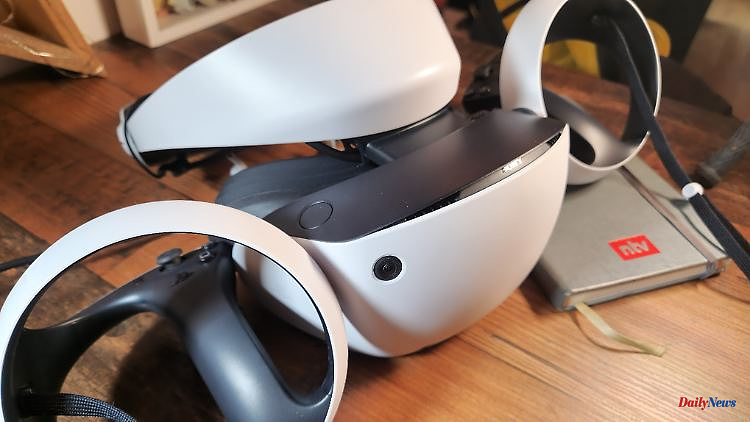VR glasses are often notorious for being bulky and too heavy. The power to create real immersion in games is also missing. Sony wants to do better with the PSVR 2. ntv.de has tested whether the developers have succeeded in making a big splash.
Virtual reality sounds like the future and has been heralded as the next big thing in the video game industry for years. So far, the technical implementations have not been able to reach the masses. With the PSVR 2, Sony is now launching new VR glasses for the Playstation 5. ntv.de tested the device and checked whether it was worth buying.
While Meta has been regularly launching wearable VR headsets with the Oculus for years, the VR version of the Playstation 4 is already seven years old. The new PSVR 2 is a massive improvement over its predecessor in almost every way in line with technological advances. The external camera and processor boxes are gone. Now you can simply plug the headset directly into the front of a PlayStation 5. The old Move controllers have also been upgraded to more robust Sense controllers.
One of the biggest hurdles to VR is comfort. A large headset that's so comfortable you won't even know you're wearing it - with the PSVR 2, Sony manages this balancing act, largely because it's so easy to set up and modify. From the outside, the headset, which is kept in the black and white of the console, is certainly a bit bulky, but at 560 grams it is lighter than its predecessor. The goggle module can be slid forward or backward along a rail and the headband is strong enough to ensure a firm hold and distribute the weight. There is a large knob on the back that allows you to tighten the headband to your liking. Compared to the Meta's quest, the PSVR 2 is a bit more comfortable overall.
The lenses inside the headset can be adjusted with a dial on the outside to pull them closer or further apart. An enormously important controller, after all, this is how the sharpness of the VR view can be adjusted. In addition to the 4.5 meter long connection cable, the package also includes a pair of earplugs that are connected to the back of the headset. Any other headphones with a 3.5 mm plug can also be connected there. That might not be a bad option either, as the audio quality is on the mediocre side with the included wired ear buds. Good sound is actually essential for the VR experience.
Unlike other providers, the VR image is streamed at the same time via the console to the connected television. So the whole living room can see how and why you're waving your arms around so wildly.
Once put on, the magic of PSVR 2 unfolds. Eye tracking in particular is an outstanding feature. After a short initial calibration, the headset is able to recognize where you are looking. It works so precisely that you can control a mouse cursor with your eyes in the menu. It may take some getting used to at first, but it allows you to navigate the menus extremely quickly.
When it comes to image quality, Sony's new gem delivers in full. The OLED displays allow HDR and a resolution of 2000 x 2040 pixels per eye. Combined with an image frequency of 120 Hertz (HZ), this ensures extremely sharp and fluid images despite the many movements. This is supported by "Foveated Rendering", a tracking system that follows the focus of the glasses wearer and then offers a higher resolution in this area.
The PSVR 2's controllers are similarly innovative, although most will feel fairly standard for PS5 owners. The haptic feedback on the keys and the precise vibrations ensure great moments. For example, when you fire an arrow with your bow, you can feel the string vibrating. Even the headset conveys shocks or impacts with vibrations in the head area.
To a limited extent, the movement of individual fingers can also be tracked. Open palm, fist, the peace sign, pointing the index finger at something - these are typical hand movements that can be integrated into video games in this way. A small negative aspect is the battery life of the controllers. Because they only last three hours when fully charged. That's a long time for a VR experience, though.
And when it comes to games, the PSVR 2 unfortunately (still) has its major weakness. There are still few high-quality titles that offer strong immersion, i.e. ensure that the user mistakes the virtual for the new reality. After all, with "Horizon: Call of the Mountain" Sony has co-developed an exclusive title that skilfully stages VR glasses. From cinematic passages to climbing interludes to action with a bow and arrow, this game is probably the best advertisement for the PSVR 2. Some characters react to the focus of the gaze: If you stare into the eyes of your counterpart for a long time during a conversation, he/she turns his/her restless look off This gives the feeling that the virtual character has a real presence.
Apart from "Call of the Mountain", we were able to test "Gran Turismo 7". There is a free VR upgrade for this game and the PSVR 2 also works very well in racing, albeit with slight graphical drawbacks. With the release of the VR glasses, many developers have announced new games. If you have already bought VR games for the old PSVR, look into the tube: PSVR 2 is not backwards compatible.
And so a lot comes together if you want to have this ingenious VR experience. You need a PS5 anyway (550 euros), the PSVR 2 itself (600 euros) and a suitable game like "Call of the Mountain" (70 euros). The proud starter package would be over 1200 euros. The price is put into perspective a little when you look at other high-quality VR glasses like the Meta Quest Pro. Because it's a bit more expensive, but only partially more powerful than the PSVR 2. Maybe it's not the best time to strike right now. With each new high-quality game title, however, the headset becomes significantly more attractive. And the PSVR 2 experience does seem like a glimpse into the future of video gaming.












